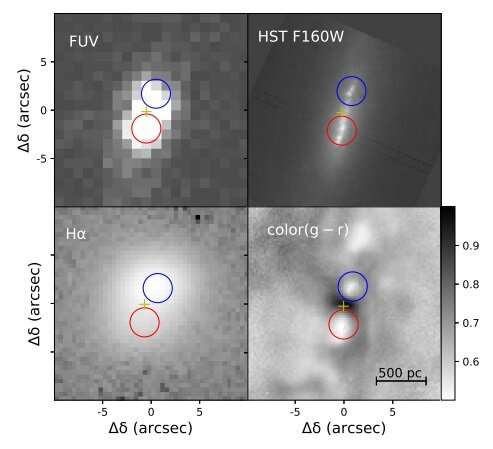February 11, 2020 report
Double nuclei in the galaxy IC 676 investigated by researchers

Chinese astronomers have carried out spectroscopic observations of the lenticular galaxy IC 676. Results of these observations provide more insights into the nature of the galaxy's double nuclei. The study was detailed in a paper published January 31 on the arXiv pre-print repository.
Lenticular galaxies (also called S0s) are considered to be intermediates between spiral and elliptical galaxies. They have a shape reminiscent of a lens, exhibit a bulge and disk similar to spiral galaxies, but do not have spiral arms.
Nuclear regions in galaxies are their important structural components that could provide important information about galactic formation and evolution. Of special interest are peculiar nuclear morphologies such as double or multiple nuclei observed in galaxies.
Located about 65 million light years away, IC 676 is a barred lenticular galaxy with an estimated stellar mass of 1.3 billion solar masses. It shows nuclear morphology consistent with double nuclei, with a projected distance between the nuclei of about 650 light years along the major axis of the galaxy. Observations have shown that IC 676 has active star formation in its central region with star-formation rate (SFR) at a level of approximately 0.28 solar masses per year.
A team of astronomers led by Zhimin Zhou of the Key Laboratory of Optical Astronomy in China, has conducted long-slit spectroscopic observations of IC 676 using the BAO Faint Object Spectrograph and Camera (BFOSC) on the 2.16-meter telescope at Xinglong Observatory. The study was focused on the nature of the galaxy's double nuclei, and the researchers hoped that the observations would set important constraints to the physical processes included in galaxy evolution. For the purpose of the research, the scientists also used archival data from the Canada France Hawaii Telescope (CFHT) and Hubble Space Telescope (HST).
"In this work, we present the long-slit spectroscopy and archival multi-wavelength images to investigate the nature and origin of the double nuclei in IC 676," the astronomers wrote in the paper.
The observations found that the double nuclei (northern and southern) of IC 676 contains several young massive star clusters (YMCs). The results show that these young stellar populations are between one and 10 million years old.
According to the research, the northern nucleus has stronger star formation activity and higher dust extinction than the southern one, though both nuclei have similar stellar metallicity. The astronomers emphasized that the star formation activity is the main source of gas ionization in the double nuclei of IC 676.
Furthermore, the star formation rates were calculated to be 0.19 and 0.08 solar masses per year for the northern and southern nucleus, respectively. This confirms that nearly all of the star formation in IC 676 is concentrated in its double nuclei.
Summing up the results, the researchers concluded that IC 676 likely has a complex formation and evolutionary history.
"The secular processes may primarily contribute to the formation and evolution of the double nuclei. The gas in IC 676 is likely affected by the stellar bar and driven into the inner regions of the galaxy, resulting in the star formation activity. The interference of galaxy interaction is likely to be negligible," the authors of the paper explained.
Therefore, according to the scientists, the results seem to suggest that the secular evolution involving the internal or external drivers may have an important contribution for the evolution of lenticular galaxies.
More information: The Nature of the Double Nuclei in the Barred S0 Galaxy IC676, arXiv:2001.11418 [astro-ph.GA] arxiv.org/abs/2001.11418
© 2020 Science X Network





















